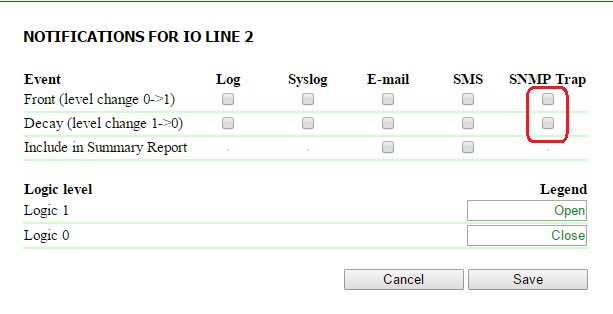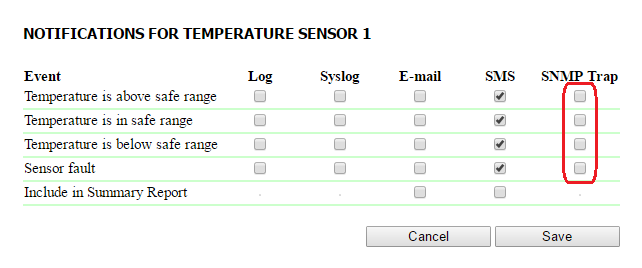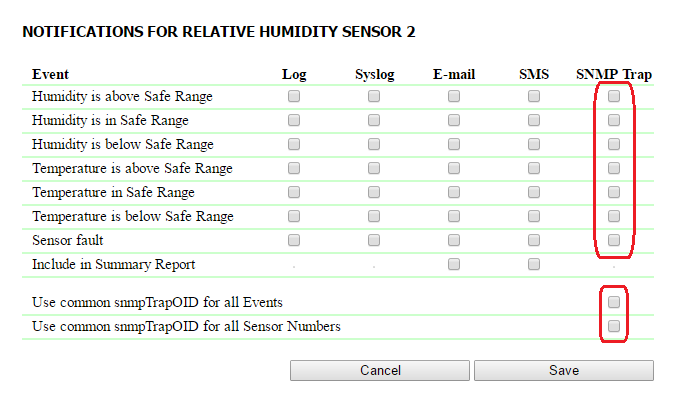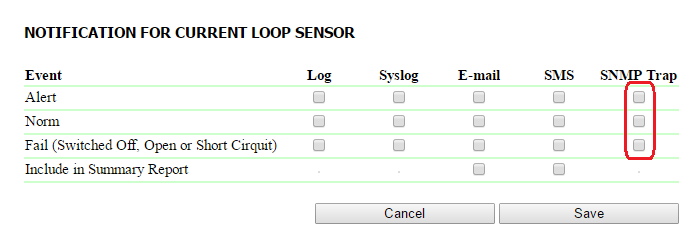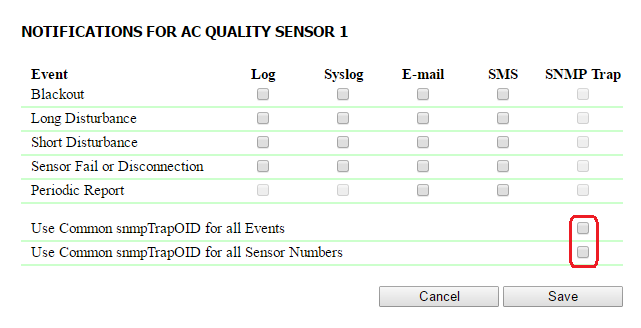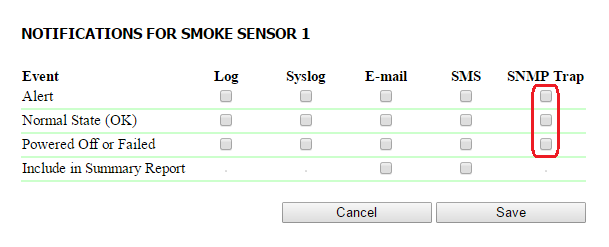[ENG] 16.2. [DKSF 70/71.6 IU] Configuring Sending SNMP TRAP Notifications
To access a device via an SNMP v1 protocol, there is a need to configure the next parameters using a device web interface:
- Community for Read – is a password, which is necessary to be indicated in any request for reading parameters via an SNMP protocol. It is indicated in the section «Access restrictions» on the page «SETUP» of a device web interface;
- Community for Write – is a password, which is necessary to be indicated in any request for writing parameters via an SNMP protocol. It is indicated in the section «Access restrictions» on the page «SETUP» of a device web interface
To send TRAP notifications by a device via an SNMP v1 protocol, there is a need to configure the next parameters using the web interface:
- SNMP Trap Destination #1 – is an IP address, where TRAP notifications will be sent. It is specified on the page «SETUP» of a device web interface;
- SNMP Trap Destination #2 – is the second (auxiliary) IP address, where TRAP notifications will be sent. It is specified on the page «SETUP» of a device web interface;
- Front (level change 0->1) – is a checkbox that allows sending SNMP TRAP notifications when a logic level of an IO line in the mode «input», «output», «logic output» is changed from low to high (signal front). It is configured by the button «Setup» on the page «DISCRETE IO» of a device web interface;
- Decay (level change 1->0) – is a checkbox that allows sending SNMP TRAP notifications when a logic level of an IO line in the mode «input», «output», «logic output» is changed from high to low (signal decay). It is configured by the button «Setup» on the page «DISCRETE IO» of a device web interface;
- Temperature is above safe range – is a checkbox that allows sending SNMP TRAP notifications when a top threshold of the norm specified for this sensor is exceeded. It is configured by the button «Setup» on the page «TEMPERATURE» of a device web interface;
- Temperature is in safe range – is a checkbox that allows sending SNMP TRAP notifications when a temperature at this temperature sensor is back to the specified range. It is configured by the button «Setup» on the page «TEMPERATURE» of a device web interface;
- Temperature is below safe range – is a checkbox that allows sending SNMP TRAP notifications when a temperature falls below the threshold, specified for this sensor. It is configured by the button «Setup» on the page «TEMPERATURE» of a device web interface;
- Sensor fault – is a checkbox that allows sending SNMP TRAP notifications when the sensor operation fails if the sensor fails, etc. It is configured by the button «Setup» on the page «TEMPERATURE» of a device web interface;
- Humidity is above Safe Range – is a checkbox that allows sending SNMP TRAP notifications when values of a relative humidity rose above the top threshold of a safe humidity range, which is specified for this sensor. It is configured by the button «Setup» on the page «HUMIDITY» of a device web interface;
- Humidity is in Safe Range – is a checkbox that allows sending SNMP TRAP notifications if a relative humidity at this humidity sensor is back to the specified range of a normal humidity. It is configured by the button «Setup» on the page «HUMIDITY» of a device web interface;
- Humidity is below Safe Range – is a checkbox that allows sending SNMP TRAP notifications if a relative humidity value falls below the bottom threshold of a normal humidity range, specified for this sensor. It is configured by the button «Setup» on the page «HUMIDITY» of a device web interface;
- Temperature is above Safe Range – is a checkbox that allows sending SNMP TRAP notifications when exceeding a temperature value above the top threshold of a normal temperature range, which is specified for this temperature sensor. It is configured by the button «Setup» on the page «HUMIDITY» of a device web interface;
- Temperature is in Safe Range – is a checkbox that allows sending SNMP TRAP notifications if a temperature on this sensor is back to a specified normal temperature range. It is configured by the button «Setup» on the page «HUMIDITY» of a device web interface;
- Temperature is below Safe Range – is a checkbox that allows sending SNMP TRAP notifications when a temperature value decreases below the bottom threshold of a normal temperature range, specified for this sensor. It is configured by the button «Setup» on the page «HUMIDITY» of a device web interface;
- Sensor fault – is a checkbox that allows sending SNMP TRAP notifications when the sensor operation fails if a sensor fails, etc. When a humidity sensor fails, two SNMP Trap notifications are sent: one notification on the humidity while another on the temperature. It is configured by the button «Setup» on the page «HUMIDITY» of a device web interface;
- Use common snmpTrapOID for all Events and Use common snmpTrapOID for all Sensor Numbers – are the checkboxes that allow sending SNMP TRAP notifications for events from all humidity sensors in a single snmpTrapOID notification or allow dividing events and numbers of humidity sensors by different snmpTrapOID notifications, up to completely individual ones. It allows to receive individual SNMP Trap notifications for processing them in monitoring systems, for example, damping of the humidity sensor 3 or the humidity sensor 2 is normal. They are configured by the button «Setup» on the page «HUMIDITY» of a device web interface;
- Alert – is a checkbox that allows sending SNMP TRAP notifications when exceeding the threshold, specified for this sensor. It is configured by the button «Setup» on the page «ANLG SMOKE SENSOR» of a device web interface;
- Norm – is a checkbox that allows sending SNMP TRAP notifications if parameters at a current sensor are back to the specified normal range. It is configured by the button «Setup» on the page «ANLG SMOKE SENSOR» of a device web interface;
- Fail (Switched Off, Open or Short Circuit) – is a checkbox that allows sending SNMP TRAP notifications in case of switching off, failing, opening or short circuit. It is configured by the button «Setup» on the page «ANLG SMOKE SENSOR» of a device web interface;
- Use common snmpTrapOID for all Events and Use common snmpTrapOID for all Sensor Numbers – are checkboxes that allow sending SNMP TRAP notifications for all events from all 220 V voltage sensors by a single snmpTrapOID notification or allowing to divide events and 220 V voltage sensor numbers by different snmpTrapOID notifications, up to totally individual ones. This allows receiving individual SNMP Trap notifications for processing them in monitoring systems;
Alert – is a checkbox that allows sending SNMP TRAP notifications if a smoke sensor determined a presence of smoke. It is configured by the button «Setup» on the page «1W SMOKE SENSORS» of a device web interface;
Normal State – is a checkbox that allows sending SNMP TRAP notifications if a smoke sensor is switched to the normal status. It is configured by the button «Setup» on the page «1W SMOKE SENSORS» of a device web interface;
Powered Off or Failed – is a checkbox that allows sending SNMP TRAP notifications in case of losing a connection or when switching off the power of a smoke sensor. It is configured by the button «Setup» on the page «1W SMOKE SENSORS» of a device web interface;


